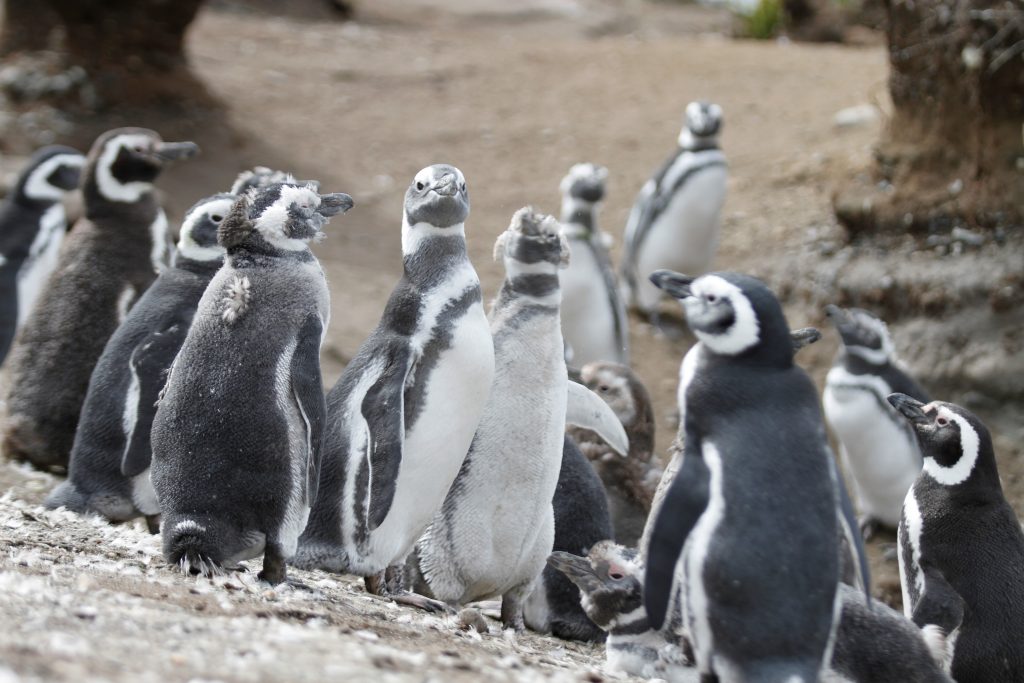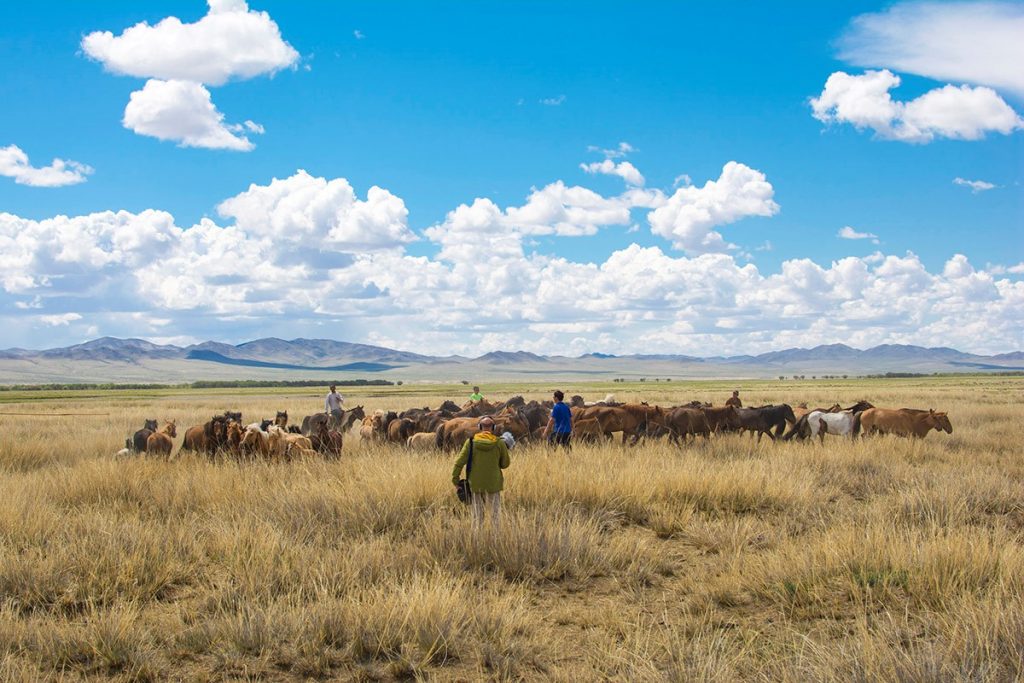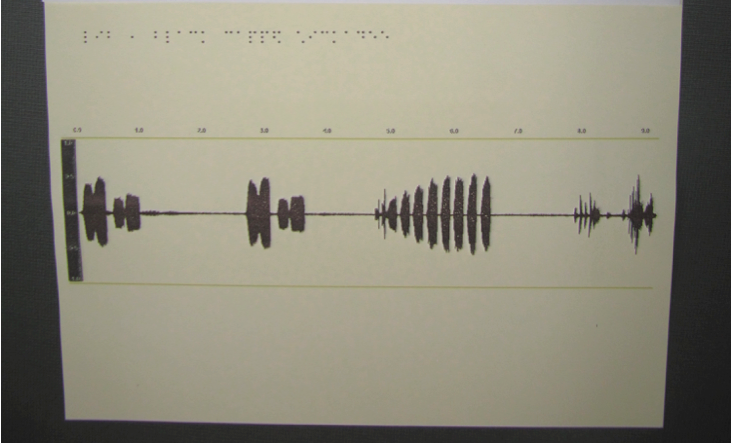Diversity and Equity
Promoting STEM Interest and Connections to Nature Through a Soundscape Ecology Camp for Students With Visual Impairments
Connected Science Learning January-March 2018 (Volume 1, Issue 5)
By Maryam Ghadiri, Dante Francomano, Kristen Bellisario, and Bryan Pijanowski
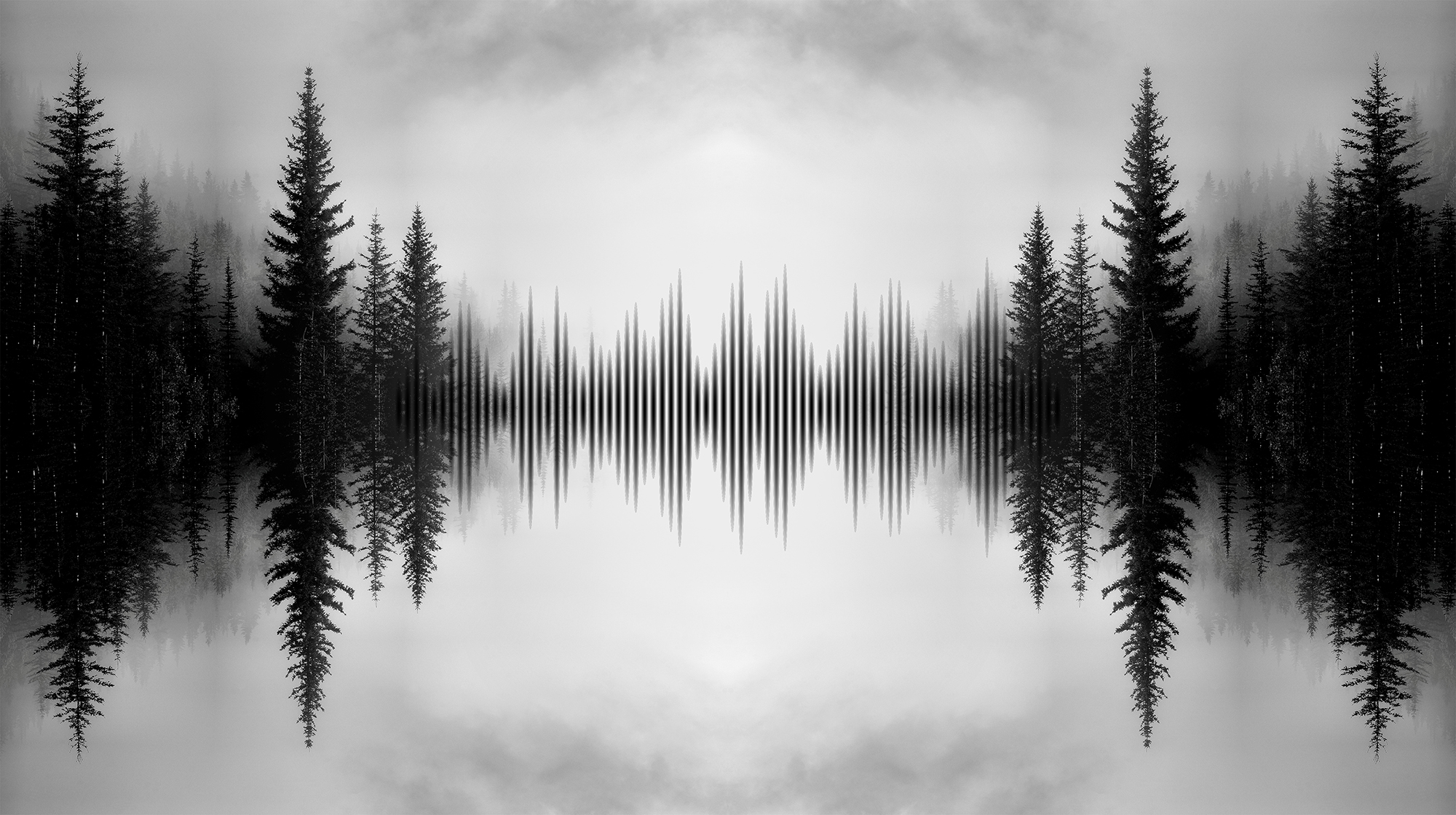
The Center for Global Soundscapes developed a five-day camp program for students with visual impairments that follows an inquiry-based learning approach to explore concepts fundamental to soundscape ecology.
Education research since the 1980s has documented a lack of broad participation across all STEM (science, technology, engineering, and mathematics) fields and a decline in STEM interest, especially among differently abled youth who have been historically marginalized and excluded from these fields (Falk et al. 2016; Fraser and Maguvhe 2008). Despite landmark legislation such as the Individuals with Disabilities Education Act (IDEA), which was designed to support students with disabilities and promote their access to quality education through classroom accommodation, these students are still significantly underrepresented in higher education (Moon et al. 2012). According to Moon et al. (2012), individuals with disabilities account for 13.7% of the school-age population, but only represent 9%–10% of students pursuing undergraduate STEM degrees and only 5% of students pursuing graduate STEM degrees (pp. 10–11). The high reliance of nearly all STEM fields on visual communication inhibits accessibility for youth with visual impairments (Moon et al. 2012). For example, the use of visuals such as graphs and diagrams often plays an important role in cognitive development and engagement of students, which may exclude students with visual impairments and make them feel inadequate and uncomfortable in such situations (Erwin et al. 2001; Jones et al. 2006; Moon et al. 2012). Therefore, accommodating all STEM students according to their abilities (e.g., using a multisensory approach including tactile models and audio cues for youth with visual impairments) is potentially a powerful way to reframe the concept of disability and engage a broader audience to promote equitable access to all knowledge sources.
The Center for Global Soundscapes
At the Center for Global Soundscapes (CGS) at Purdue University, ecologists, engineers, computer scientists, and musicians collaborate to study soundscape ecology. Soundscapes are collections of sounds occurring in a given place over a given period of time, and they are typically composed of sounds from multiple sources. Soundscapes can be used to detect patterns and changes of animal behavior, biodiversity, and habitat conditions, and they also impact animal communication and behavior. CGS researchers examine topics such as daily soundscape changes of a Magellanic penguin colony in Tierra del Fuego, Argentina (Figures 1 and 2) and the importance of natural sounds to pastoral culture in Mongolia (Figure 3).
Figure 2
A Song Meter SM4 installed in a colony of Magellanic penguins in Tierra del Fuego
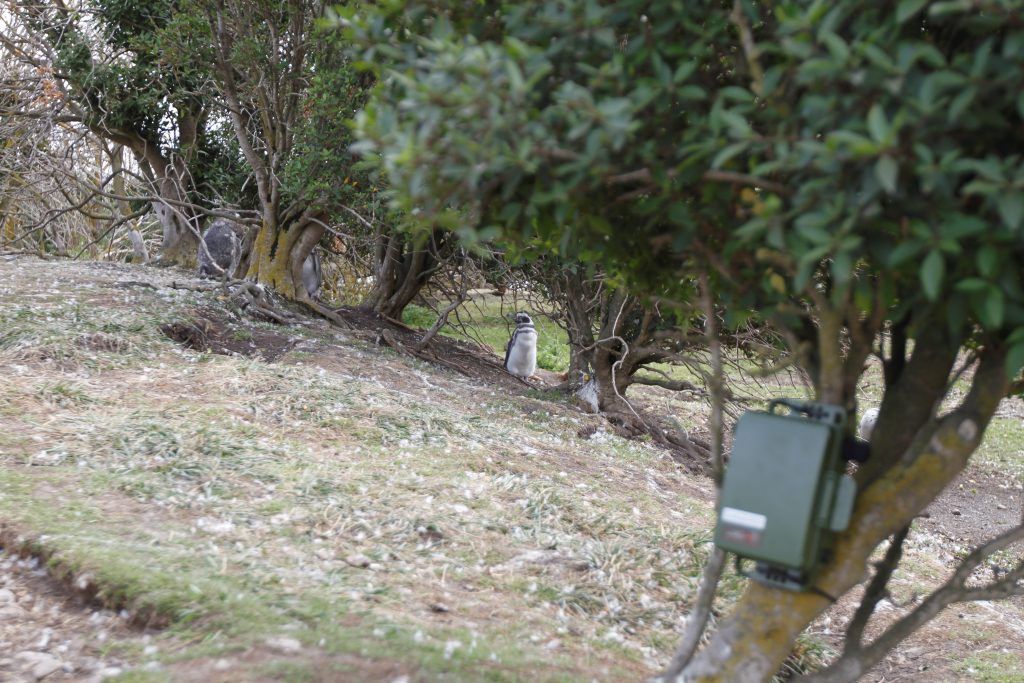
Figure 3
Bryan Pijanowski recording herding just outside the Hustai National Park, Mongolia
Additionally, the CGS is pioneering education and extension and outreach materials about soundscape ecology to raise public awareness of the environment and animal communication by encouraging people to “open their ears.” One recently released educational program is the interactive, giant screen theater show called Global Soundscapes! A Mission to Record the Earth, which showcases research by soundscape ecologists in the rain forests of Costa Rica, the coral reefs of Hawaii, and the grasslands of Mongolia. Another initiative is a citizen science program called Record the Earth, which allows people to record soundscapes on a mobile app and then upload them to a global mapping and analysis website.
Soundscape camp overview
The focus of this paper is a further CGS initiative that we developed called “Your Ecosystem Listening Labs” (YELLs), an immersive outdoor soundscape curriculum that brings together resources from CGS research and outreach programs. YELLs is an inquiry-based curriculum that engages students in sound recording, ecological fieldwork, and data analysis. The curriculum targets middle school and high school students with visual impairments, which includes students with partially limited vision as well as total blindness. YELLs was designed for a five-day camp in an informal setting, but it can be adapted to different settings and time constraints. The goals of the soundscape curriculum are to promote active listening, connect students to their outdoor environments, and raise interest in STEM-related fields. Students with visual impairments are uniquely skilled listeners (Hugdahl et al. 2004), making them particularly suited to perform the intense listening required by soundscape ecology. The camp thus introduces these students to a STEM field that is highly suited to their natural abilities.
YELLs is designed to align with the Next Generation Science Standards (NGSS) to promote development of basic knowledge and conceptual models about soundscape ecology through the actual practice of methods employed within the discipline. The NGSS emphasize integrating knowledge and concepts with practices and authentic technology, and they are crafted for specific grade levels (NRC 2012). Each activity in YELLs was designed to address dimensions of soundscape ecology framed by the NGSS (Table 1). The YELLS curriculum is accessible for no cost at the CGS’s online learning portal. YELLs has also undergone independent formative evaluation by curriculum designers, teachers, and students at the targeted grade levels to assess and improve the content and pedagogical approaches of each activity.
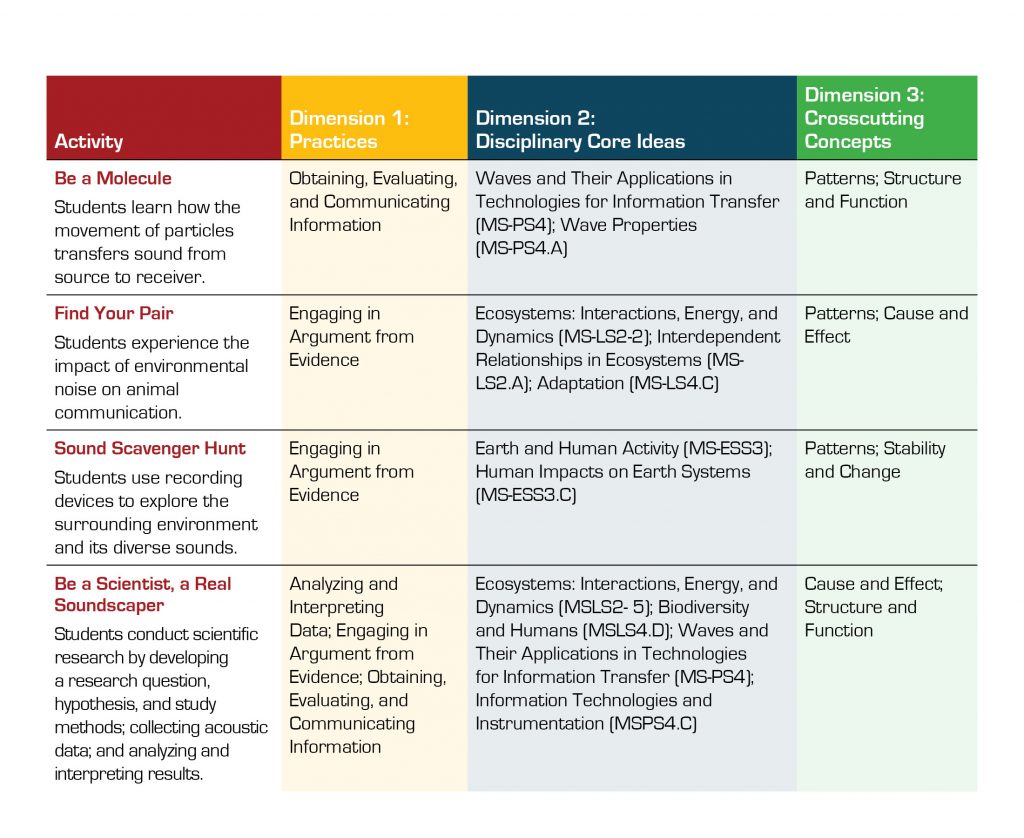
During the five-day soundscape camp, students participate in as many as 15 different activities (see Appendix A in Resources). The first activities teach the physics of sound, explore how and why animals produce sounds, and lead students to consider the interactions between natural and human-made sounds. In “Find Your Pair,” for example, blindfolded students attempt to use sound to locate a partner, but must do so while being hindered by increasing levels of natural and anthropogenic noise. In this activity, students learn how animals must evolve to produce sounds that are not masked by other sounds in their natural environment, as well as how human-made noise can impair acoustic animal communication. Later activities immerse students in their immediate acoustic environment and introduce technologies employed by soundscape ecologists. Activities such as “Sound Walk” and “Sound Map” allow students to have direct interactions with nature, practice active listening, and visit different locations around the camp to document diverse sounds. Students gain greater awareness of their acoustic surroundings through these activities. “Sound Scavenger Hunt” and “Soundscape Data Collection” teach audio recording techniques and apply those techniques to the challenges of collecting field recordings as scientific data. Students use a Zoom H2n handheld recorder and a Wildlife Acoustics Song Meter SM2 programmable field recorder, both of which are used by scientists in their research, to provide an authentic scientific experience (Figures 4 and 5). The combination of scientific inquiry and fieldwork activities help familiarize students with the concepts of soundscape ecology and prepare them for the final activity, in which they develop and answer their own soundscape-oriented research question by collecting and analyzing audio data and then interpreting the results. The final activities involve students in fieldwork and scientific practices, and they learn the essential steps of conducting scientific studies.
Figure 4
Students using a Zoom H2n to capture sounds around the Perkins campus
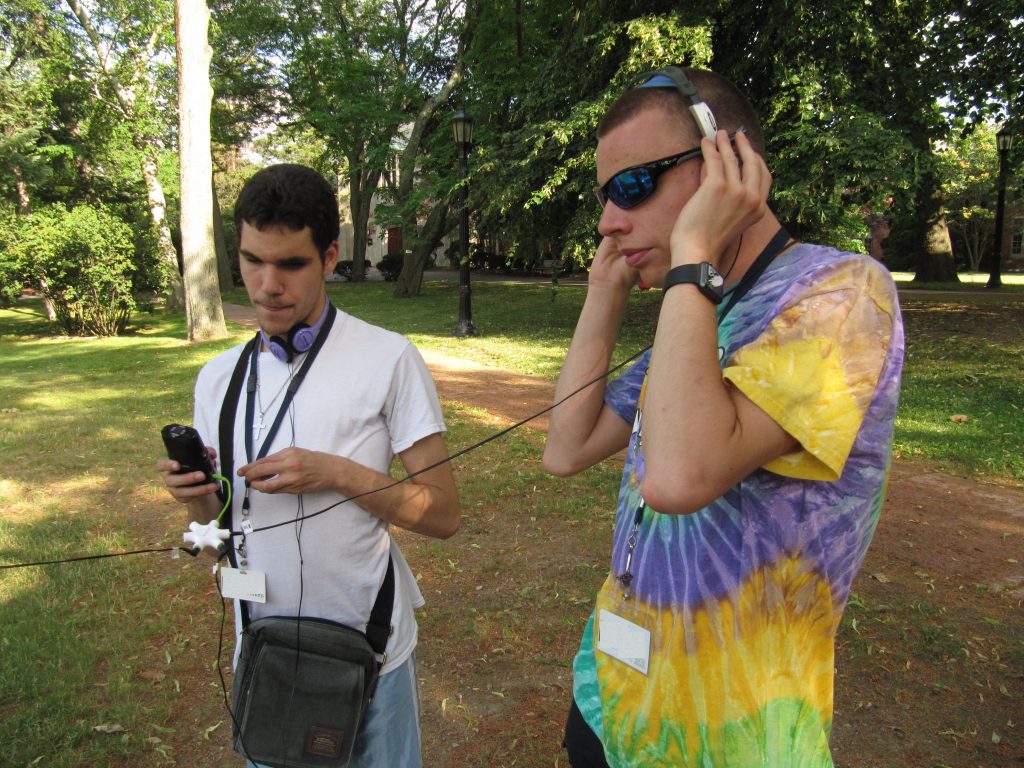
Figure 5
Maryam Ghadiri teaches a student how to record high-quality sounds on a windy day using a handheld recorder with a furry windscreen protecting the microphone
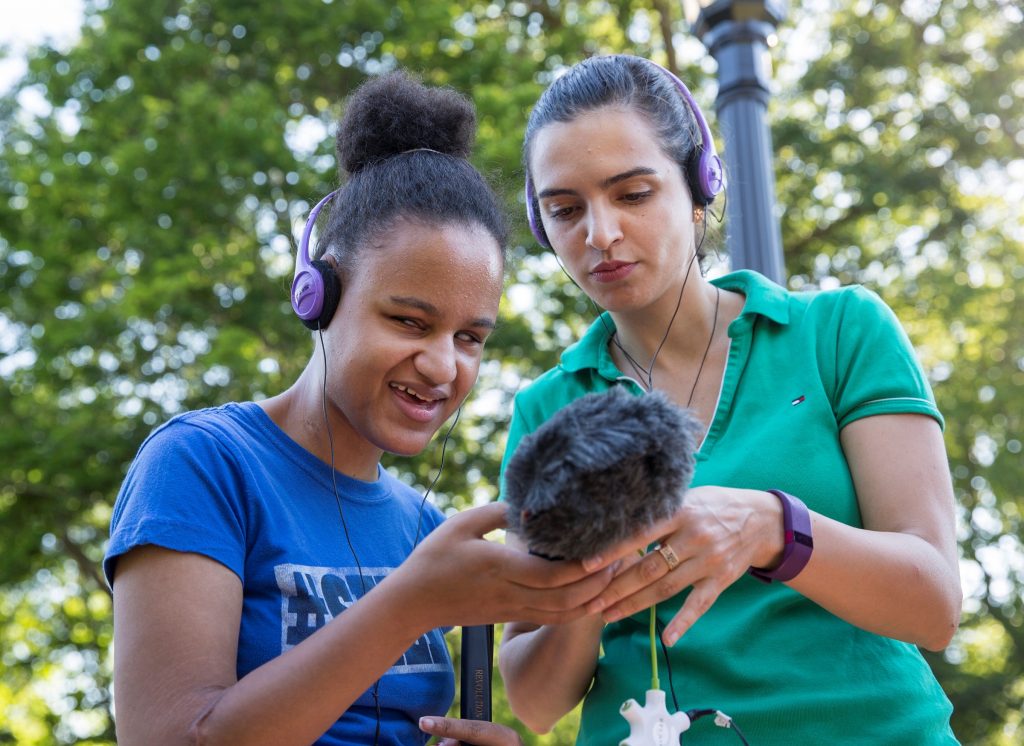
CGS collaboration with Perkins School for the Blind
CGS researchers began collaborating in April 2014 with Perkins School for the Blind (Perkins), a world leader in education for students with visual impairments since its founding in 1829. This collaboration is supported by funding from the National Science Foundation’s (NSF) Advancing Informal STEM Learning program (NSF AISL #1323615). Broad educational goals of this collaboration include:
- Teaching broadly across STEM using soundscape ecology;
- Bridging formal and informal education and promoting STEM education through an active-learning philosophy and inquiry-based learning experience;
- Connecting students to nature through soundscape immersion;
- Ensuring that STEM education resources are accessible for differently abled students;
- Developing skilled listeners into ideal candidates for higher education and future careers in soundscape ecology; and
- Enhancing problem-solving skills through hands-on, inquiry-based activities using authentic technology employed by soundscape ecologists.
Between 2014 and 2017, CGS researchers and Perkins staff and science teachers hosted several five-day soundscape camps for Perkins students (ages 14 to 22) on the Perkins campus. Activities were adapted according to the pace and the needs of the students, as some of the students had other disabilities, such as limited motor skills, in addition to their visual impairments.
Research goals
In addition to the educational aims of this collaboration, we sought to understand how students with visual impairments are impacted in the short term by an immersive introduction to soundscape ecology in an informal learning context. We documented students’ attitudes toward STEM and their surrounding environments before and after their five-day experiences with YELLs. Research questions that we posed were:
- What are some effective mediation and adaptation strategies to teach soundscape ecology to students with visual impairments?
- How does teaching a STEM-oriented topic through inquiry-based, hands-on fieldwork activities affect conceptions of and interest in STEM fields for students with visual impairments?
- How does a STEM-oriented topic that is highly dependent on acoustics and hearing impact attitudes toward nature and surrounding environments for students with visual impairments?
We used a qualitative research approach and collected data through individual, semistructured pre- and postcamp interviews and field notes from a soundscape camp in the summer of 2016. Maryam Ghadiri, lead author of YELLs and soundscape camp instructor, conducted interviews with 12 students and two science teachers (all of the 2016 participants) and recorded audio of the conversations. The pre- and postcamp interviews provided a holistic view of the knowledge, opinions, and sentiments of the participants about STEM and the outdoors. Students were asked questions such as, “How do you define a scientist? Would you like to be a scientist? If so, why?” or “Why do you think scientists study soundscapes in nature?” After transcribing the data, Maryam Ghadiri used open-coding to extract emerging themes and patterns from the collected data (Thomas 2006). Research was approved prior to data collection by the Purdue University Institutional Review Board (IRB protocol # 1505016082).
Effective teaching strategies for students with visual impairments
To develop a stronger soundscape education experience, we examined the accessibility of the soundscape camp curriculum for students with visual impairments. Based on our field notes and interviews with Perkins teachers, we found that the curriculum was most accessible when we considered the background knowledge, learning pace, and physical mobility of the current students. Strategies for instruction included connecting prior knowledge and experience to new topics, using reinforcement techniques, using instruments and technology that promote accessibility and learning, and providing real-world context that used the local environment to connect students with the subject matter. The following techniques were captured in Maryam Ghadiri’s field notes and in interviews with science teachers at Perkins:
- Create tactile images (Figure 6) or diagrams using technologies such as 3-D or thermal printing, as studies show that “visionless visualization” can be developed in students with visual impairments through the application of tactile models as a substitute for visual figures (Figures 7 and 8; Wu, Krajcik, and Soloway 2001; Moon et al. 2012). In tactile activities such as sound map production, avoid using sharp objects.
- Break up complex activities, such as designing and conducting a research project into small sections, to make them more accessible.
- Connect each section to students’ prior experiences and past activities by collaborating with teachers who regularly work with students.
- Judiciously provide support. Pairing low-vision and blind students, especially for hands-on activities, allows low-vision students to provide peer assistance to blind students when necessary. Assistants can also facilitate activities and support fieldwork, but keep in mind that students should be as fully engaged as possible with any task. Overreliance on assistants may devalue the experience for the students and undermine the goal of inclusivity within the STEM disciplines (Moon et al. 2012).
- Consider the location, accessibility, and diversity of sites for outdoor activities, and spend enough time at each site for students to become acquainted with their surroundings. In outdoor environments with changing topography or ground cover (e.g., moving from pavement to grass or onto steeper terrain), inform students in advance to prepare them for the different environment. Avoid places with dense foliage at students’ head level to prevent unexpected branch impacts. Obtaining input from people who work with students prior to outdoor activities can help in identifying locations that are known and accessible to students. While moving between sites during outdoor activities, avoid talking to students who are walking independently with canes, as they are listening to navigate their surroundings and talking may distract them. Allow students to select study sites, as it gives them autonomy.
- Teach students to program and use recording technology independently, and provide relevant apps such as Record the Earth that can be used for future, independent sound collection (Figure 9).
Figure 6
Students make a sound map using Picture Maker by placing differently shaped icons (representing different sound sources) on a Velcro surface
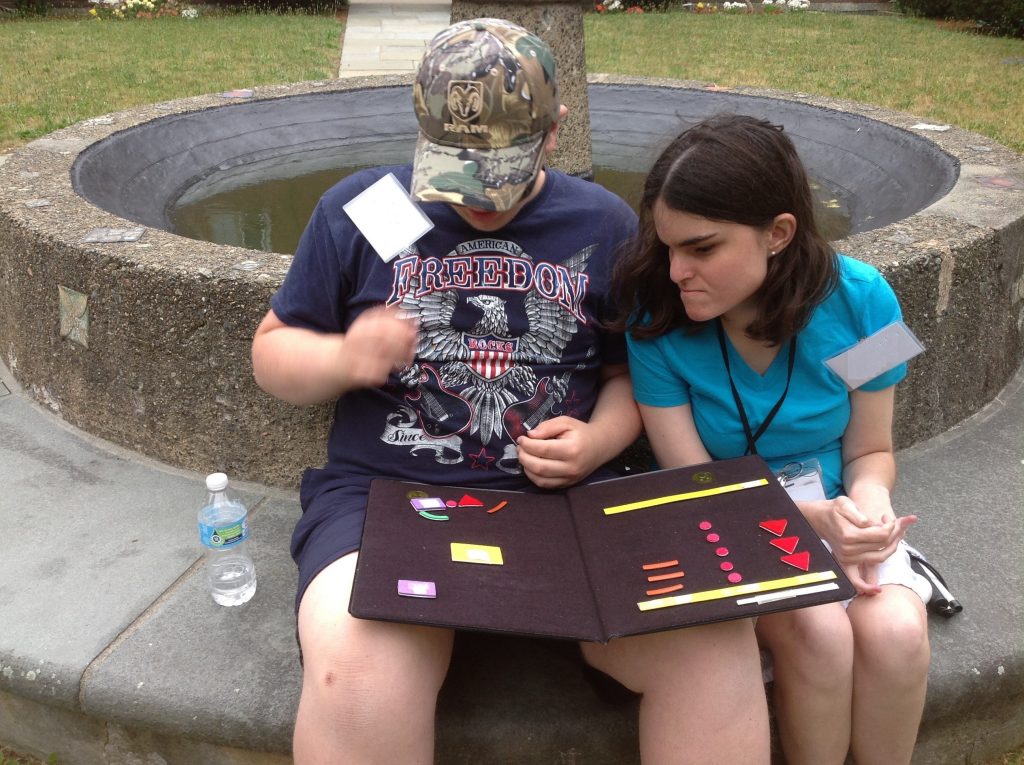
Figure 7
Tactile waveform of the sound from a black-capped chickadee printed using a thermal printer and swell paper (top) and waveform printed with a standard 2-D color printer (bottom)
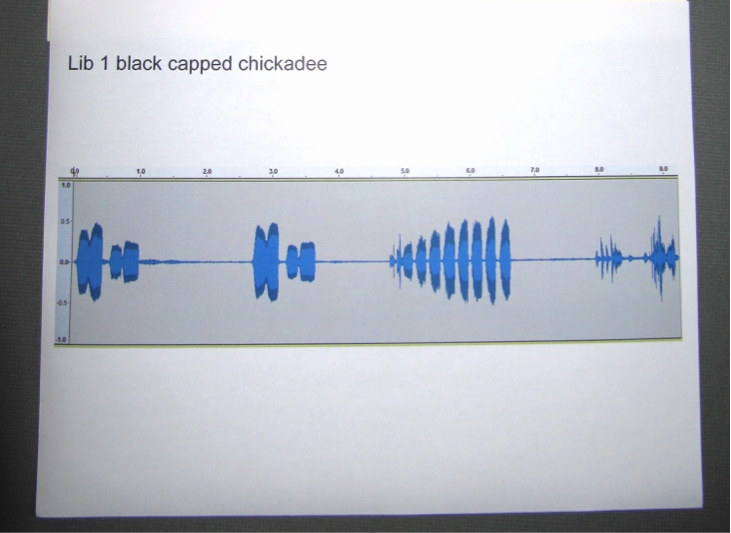
Figure 8
Students investigate a tactile spectrogram, which indicates frequency and amplitude of sounds over time
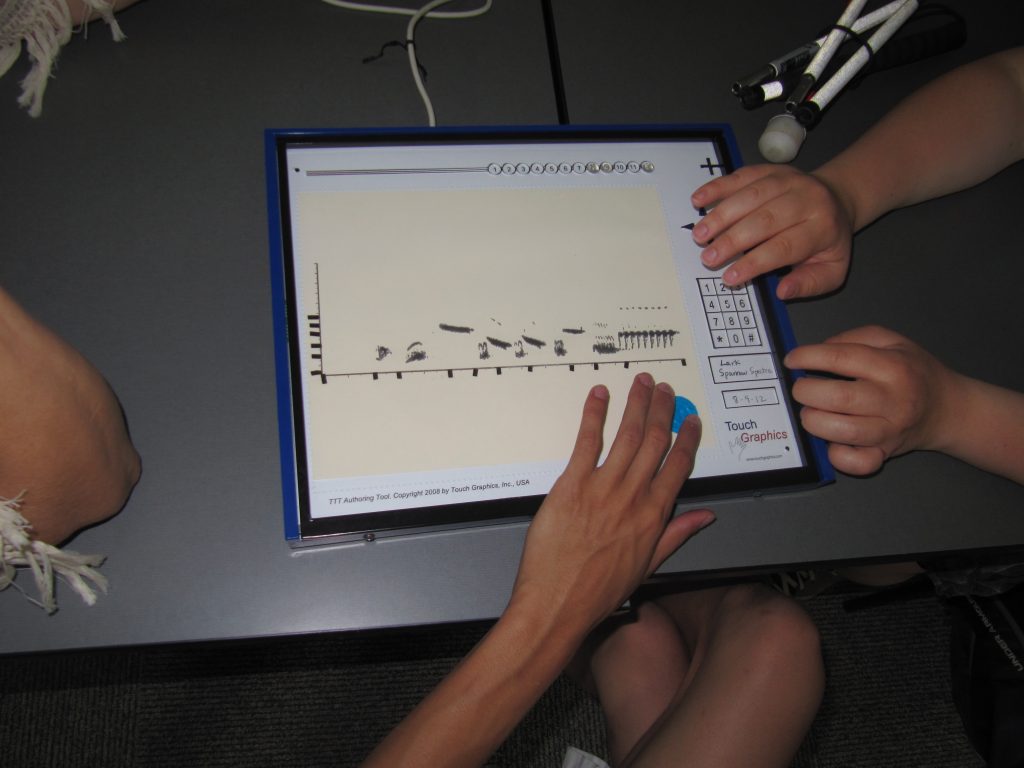
Figure 9
Students listen and record soundscapes at different locations on campus using an iPad and the Record the Earth app
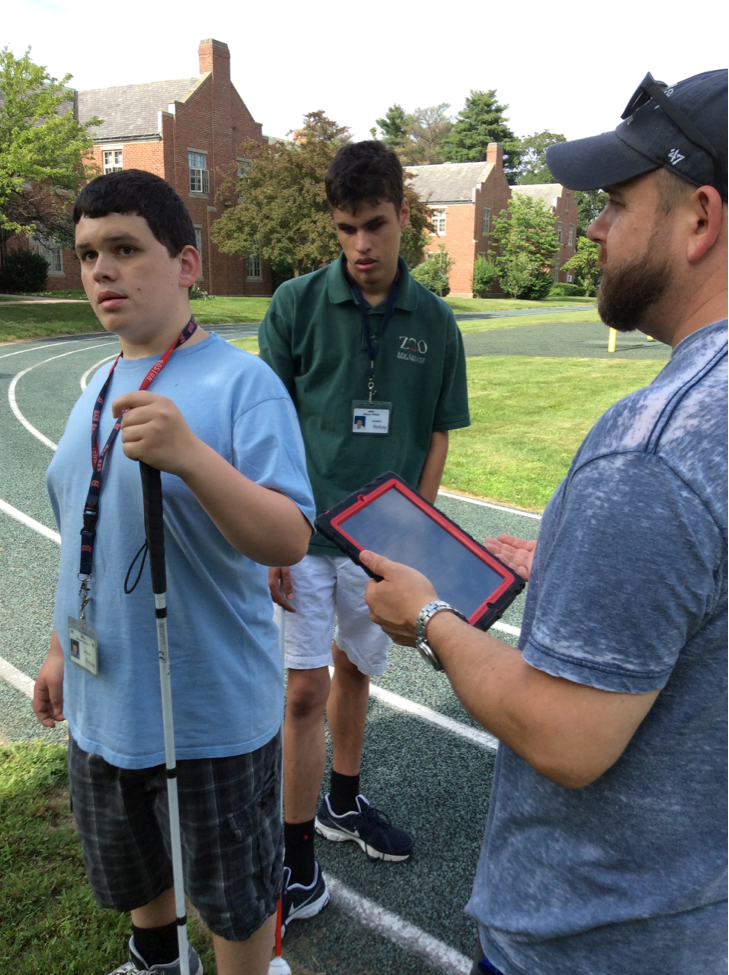
Program outcomes
The empirical findings of our assessment showed that the soundscape camp contributed to students’ cognitive and affective development. Cognitive development refers to participants’ acquisition of knowledge and development of abstract thinking; affective development pertains to emotional reactions to the learning experience, as related to feelings, motivation, values, and appreciation. In regards to cognitive learning, students demonstrated heightened ecological and scientific knowledge and applied understanding of scientific practices. Meanwhile, the affective learning experience impacted students’ appreciation for nature, motivation toward active listening, and interest in STEM- and sound-related careers.
Cognitive development
Students learned to critically analyze their surrounding environments by determining the sources of all sounds within the soundscapes they heard. Following techniques used by soundscape ecologists, they classified those sounds as “biophony” (sounds produced by non-human animals), “geophony” (sounds produced by geophysical processes), or “anthrophony” (sounds produced by humans and human-made objects) (Pijanowski et al. 2011). This type of analysis is key to evaluating how soundscapes serve as both indicators and drivers of ecological patterns and processes. To develop an understanding of this interplay, students learned about the impact of noise on animal communication and biodiversity. One student reflected: “Anthrophony can affect biophony because the animals have to be louder to adapt. Because […] there is nothing [animals] can do about it, they’re gonna have to eventually cope with it, which is going to be very hard.” This statement demonstrates this student’s newfound knowledge of sound classification terminology (i.e., “anthrophony” and “biophony”), ecological adaptation, and the costs of such adaptation, showing their ability to integrate basic ecological knowledge to understand complex ecological phenomena. The student was able to explain how environmental conditions can force an organism to adapt, and they accurately concluded that such adaptation would be difficult and costly for the organism.
A science teacher from Perkins who was involved in every soundscape camp made the following observation about how the camp increased content knowledge in the areas of physics of sound and human hearing:
This class gave our students a sense of the physical aspect of sound. Sound is often thought of as incorporeal [intangible], but when students can feel the spectrograms and learn the physics of sound, it makes sound more tangible. I think this may also help students understand the damage that loud sounds could have on their own lives.
Using tactile models of spectrograms made the concept of sound more accessible to students and helped to improve their understanding of the physics of sound while simultaneously enabling practical application of that knowledge.
Throughout the camp, students gained an applied understanding of scientific practices. They developed abstract thinking skills through active engagement with the scientific research process. On the last day, students conducted their own soundscape research projects and worked in teams to define relevant research questions. Each team used recordings as data to design its own study, employing acquired soundscape concepts to analyze their data and draw conclusions about their research questions. For instance, one group posed the question, “What is the difference in soundscape diversity between two habitats—a pond and a garden?” One student explained why this project appealed to him:
I like … being able to [design] our own question and try[ing] to build off that and see where you end up because I thought that … it gave my brain more thought—like, “Where can this go? How would this sound change?” … Like, the hardest part was figuring out what would be a good hypothesis …
The activities challenged students to promote systematic thinking about their surrounding environments.
Exposure to scientific tools also promoted the practical application of scientific practices, as students learned how scientists use tools to collect and analyze data. In soundscape camp, students used a Wildlife Acoustics Song Meter SM2 to collect audio data, and they mastered the process of programming and deployment (Figure 10). Later, they learned how to interpret the recordings for scientific purposes. A student who was captivated by recording technology offered,
I would say [that] my favorite [activity] was when we went outside and we would record our own soundscapes […]. It was very fun when we would record and we would get a little bit of each category [biophony, geophony, and anthrophony] on a recording.… We could [program the Song Meter to] record at different locations and time[s], even at night! Then we [could] make the diagram of the sound waves [that] was so accurate to the sound.
This student clearly demonstrated awareness of how a Song Meter could be deployed to collect spatial and temporal data and the categorization and visualization techniques with which those data could be analyzed.
Figure 10
Maryam Ghadiri introduces a student to a Song Meter SM2 and teaches her how to program it
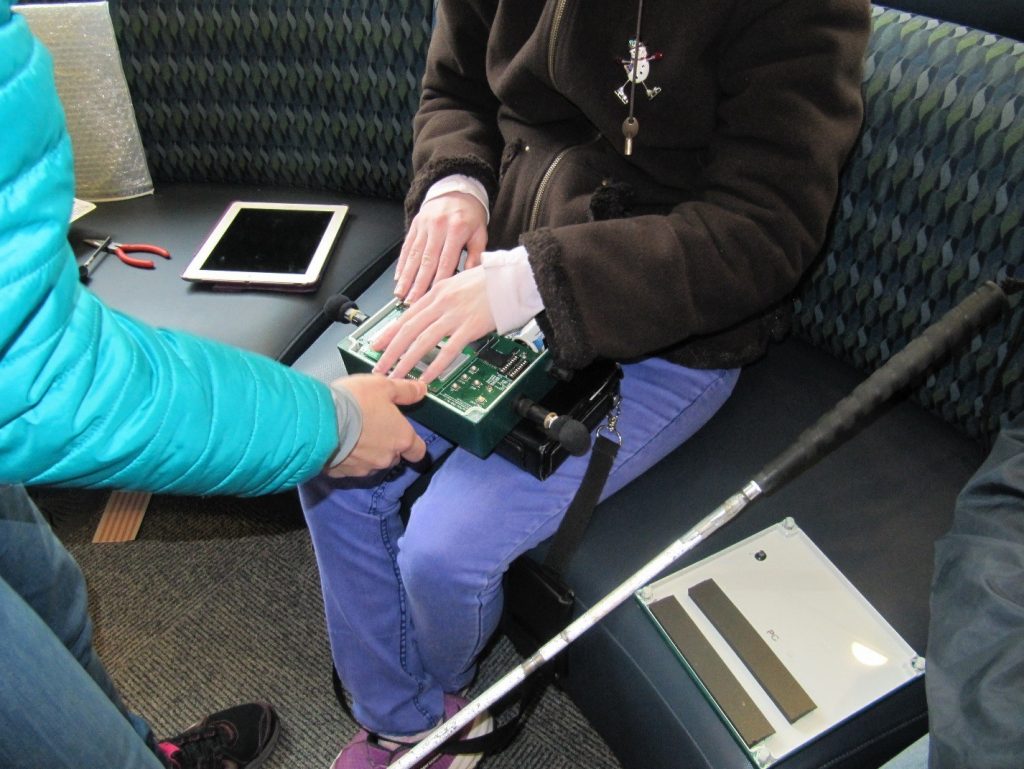
Affective development
In addition to cognitive development, students experienced joy, excitement, and social interaction—all important contributors to affective development. The soundscape camp had a positive affective impact by increasing students’ appreciation for nature, encouraging active listening to their surroundings, and triggering an interest in STEM- and sound-related careers.
Students’ exposure to acoustic recordings of many ecosystems and interaction with nature on the Perkins campus promoted their appreciation for nature. Listening to diverse soundscapes was a key factor that sparked the students’ interest from the first moment of the camp. Field notes highlighted the fact that students were fully engaged with activities that promoted listening, whether the activities exposed students to diverse soundscapes from different global ecosystems or encouraged outdoor exploration and sound walks at different locations on the Perkins campus. Students showed excitement and joy at being able to explore any ecosystem, and they were especially enthralled by animal sounds and the spatial and temporal diversity of the soundscapes they heard. Their persistence in listening to additional soundscapes from different ecosystems or repeatedly requesting to hear more biophony and discuss how and why those sounds evolved are illustrative of student fascination with nature. When asked, “What is one of the most significant things that you’re going to take with you from this camp?” one student replied that they walked away with “a respect for nature.” Their outdoor experiences helped students become aware of the complexity of soundscapes in their immediate environments and led to new appreciations for sound and nature.
Various outdoor activities introduced students to deliberate listening practices. Students who already had great listening skills were inspired to surpass acoustic awareness and become active listeners by focusing their attention on what natural sounds mean and how they are used by scientists. Exposure to diverse sounds in their immediate surroundings changed the way in which students perceived their environments. Students shared that the camp taught them to listen more actively and motivated them to explore outdoor environments to listen to soundscapes. One student mentioned in the precamp interview that he uses sounds to “locate things.” The same student referred to active listening as “sight to ears,” in the postcamp interview and added that “[soundscape camp] inspired me [to] just go outside on my porch—just go randomly outside and record things that I used to not really think about that much, but [that] I think about … a lot more now.” Even these students, who were already exceptionally acoustically aware due to their visual impairments, left camp with heightened acoustic attention and greater interest in deliberate listening practices.
Fieldwork and use of authentic scientific equipment sparked curiosity and led to student interest in STEM- and sound-related careers. As students engaged in scientific practices while incorporating these elements, they gained confidence and comfort that allowed them to identify with scientists and envision their potential for success in STEM- and sound-related careers. When asked in a precamp interview what scientists do and whether he would want to be one, a student responded, “A scientist stud[ies] science topic[s]. A scientist will go and see what types of disease there [are] in the world. [I don’t want to be a scientist because] it would be a lot of work for me.” After, the same student wanted to be a “soundscaper” and shared,
I [thought] a scientist […] was someone like from [the] medical [fields or] something—you know, a big professional geek, [studying] stuff and things that I wouldn’t understand—but now […] I realize […], in a way, we kind of can all be scientists. Because a scientist is just an ordinary person who is extremely intrigued, curious, and really wants to know about something that they don’t understand. And they take a leap of faith.
This student clearly changed his perception of scientists and now sees himself as capable of actually being a scientist.
In general, the soundscape camp used the personal experiences of students with visual impairments, who rely on sound daily, to engage and inform them about STEM topics. Activities were familiar at first and based on everyday experiences with sound, but then gradually became more challenging throughout the duration of the camp based on a scaffolding approach that helps students build knowledge and gain confidence in practicing science. This approach allowed students to identify with the topic and learn about soundscape ecology by becoming more aware of natural sounds, their importance in ecology, and the impacts of humans on ecosystems.
Conclusion
This study has demonstrated that YELLs, an informal learning curriculum about soundscape ecology, is a highly effective tool for encouraging STEM interest and connection with nature in students with visual impairments. Student interviews and field notes revealed many students who expressed increased interest in STEM and heightened connection with nature after participating in the soundscape camp. Students with visual impairments already perceive environments largely through sound, and many navigate through mental sound maps of their surroundings (Hugdahl et al. 2004). Observing the environment through the lens of soundscape ecology enhances this skillset and develops a stronger appreciation for nature that is grounded in STEM.
Teaching students with visual impairments presents certain challenges, especially concerning outdoor fieldwork and concepts that are typically presented through visual media, but we identified techniques that made the soundscape camp accessible for these students in a way that maximized their independence and autonomy. The cognitive and affective development expressed by students underscores the success of these efforts. Through direct interaction with nature and active learning, students increased their awareness about their surrounding environments and came to identify with STEM-based careers.
We sought to flip the paradigm of disability by introducing students to a field in which their heightened aural skills were a unique asset, and this approach could likely be applied to other topics for students of varying abilities. We hope that others may be inspired by this curriculum and introduce it and adaptations in various settings.
Acknowledgments
The work was supported by the National Science Foundation’s Advancing Informal STEM Learning program (NSF AISL #1323615). We thank Perkins School for the Blind for supporting this study by allowing and assisting with camp implementation and data collection. Specifically, we would like to thank Jeff Migliozzi, Kate Fraser, Betsey Sennott, and Betsy Bixler for their help in conducting the soundscape camp as well as their helpful comments on earlier drafts of this manuscript.
Maryam Ghadiri (ghadiry85@gmail.com) is a postdoctoral researcher at the Center for Community and Citizen Science at University of California, Davis, in Davis, California. Dante Francomano (dfrancom@purdue.edu) is a PhD graduate research assistant at the Center for Global Soundscapes and the Department of Forestry and Natural Resources at Purdue University in West Lafayette, Indiana. Kristen Bellisario (kbellisa@purdue.edu) is a PhD graduate research assistant at the Center for Global Soundscapes and the Department of Forestry and Natural Resources at Purdue University in West Lafayette, Indiana. Bryan Pijanowski (bpijanow@purdue.edu) is director of the Center for Global Soundscapes and professor in the Department of Forestry and Natural Resources at Purdue University in West Lafayette, Indiana.



